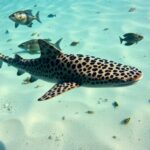Key Takeaways
- Sharks Are Present but Rarely Encountered: While various shark species inhabit the waters around Punta Cana, actual interactions with them are infrequent, allowing beachgoers to relax.
- Common Shark Species: Nurse sharks and Caribbean reef sharks are the most commonly found species, both known for their non-aggressive behavior towards humans.
- Understanding Shark Behavior: Many sharks, such as hammerheads and silky sharks, are non-threatening and prefer deeper waters, reducing the likelihood of human encounters.
- Safety Tips to Minimize Risks: Avoid swimming at dawn and dusk, stay in groups, and refrain from splashing excessively to lessen the chances of attracting sharks.
- Engaging in Shark-Related Activities: Visitors can enjoy shark diving tours, snorkeling adventures, and educational programs to learn about these creatures while ensuring a safe experience.
- Conservation and Eco-Tourism: Participating in local conservation initiatives helps protect shark populations and supports sustainable practices in Punta Cana’s marine ecosystem.
If you’re planning a trip to Punta Cana, you might be wondering about the marine life lurking beneath the crystal-clear waters. One question that often comes up is whether there are sharks in the area. The good news is that while sharks do inhabit the waters around Punta Cana, encounters with them are quite rare.
Most sharks found here are not a threat to humans, with species like nurse sharks and reef sharks being common. These gentle creatures usually prefer deeper waters and are more interested in their natural prey than in interacting with beachgoers. So, as you soak up the sun and enjoy the stunning coastline, you can relax knowing that your chances of encountering a shark are slim.
Overview of Sharks in Punta Cana
Sharks inhabit the waters around Punta Cana, yet encountering them remains infrequent. Various species dwell in this region, with a focus on those that pose minimal risk to swimmers and divers. Below is a table outlining key shark species found in Punta Cana along with their characteristics.
| Shark Species | Description | Behavior towards Humans | Typical Habitat |
|---|---|---|---|
| Nurse Shark | Slow-moving, bottom-dwelling shark | Generally non-aggressive | Reefs and sandy bottoms |
| Caribbean Reef Shark | Agile predator, can grow up to 8 feet | Slightly more cautious | Coral reefs |
| Hammerhead Shark | Distinctive head shape, large species | Rarely attacks humans | Deeper waters |
| Tiger Shark | Robust body, known for diverse diet | Can be dangerous in certain conditions | Open ocean and deeper areas |
Nurse sharks and Caribbean reef sharks represent the most commonly seen species. Despite their presence, their behavior typically avoids confrontation. Shark activity often occurs in deeper waters while recreational swimming and snorkeling occur in shallower zones, minimizing risk.
Sharks generally feed on smaller fish and crustaceans. Their diet choice lessens direct interaction with humans. Most healthy adult individuals maintain a natural wariness towards people, further diminishing the likelihood of encounters.
In rare situations of shark sightings, maintaining calmness and slowly moving away from the area ensures safety. Beachgoers may appreciate the rich marine diversity without fear, knowing that protective measures and awareness strategies enhance their beach experience.
You can enjoy the vibrant aquatic life along the coast, confident in the knowledge that while sharks share these waters, interactions with them remain exceedingly rare.
Common Shark Species in Punta Cana
Punta Cana is home to various shark species, enhancing the region’s rich marine biodiversity. Here are some common species you might encounter.
Reef Sharks
| Species | Characteristics | Behavior Towards Humans |
|---|---|---|
| Caribbean Reef Shark | Agile, streamlined body, typically greyish | Cautious, generally avoids humans |
| Silky Shark | Sleek, large dorsal fin, shimmery appearance | Shy but curious, prefers deeper waters |
Reef sharks such as the Caribbean reef shark and silky shark inhabit the waters around Punta Cana. Caribbean reef sharks display agility and a streamlined body, often seen around coral reefs. They tend to be cautious, generally avoiding human interactions. Silky sharks exhibit a shimmery appearance and large dorsal fins, favoring deeper waters over close coastal areas. Both species primarily feed on smaller fish, minimizing the chances of interaction with swimmers.
Hammerhead Sharks
| Species | Characteristics | Behavior Towards Humans |
|---|---|---|
| Great Hammerhead | Distinctive hammer-shaped head, large size | Typically non-aggressive |
| Scalloped Hammerhead | Curved head edges, slightly smaller size | Generally avoids humans |
Hammerhead sharks, including the great hammerhead and scalloped hammerhead, occasionally venture close to Punta Cana’s shores. The great hammerhead is distinguished by its large size and unique head shape, which assists in hunting. Despite their imposing appearance, they are typically non-aggressive toward humans. Scalloped hammerheads are slightly smaller and characterized by curved head edges; they generally avoid human presence. Both species hunt for smaller fish and are not known for frequent encounters with beachgoers.
Safety Considerations for Shark Encounters
Staying informed about sharks around Punta Cana enhances your beach experience. While shark encounters remain rare, understanding behavior and safety tips can boost your confidence.
Understanding Shark Behavior
Shark behavior directly affects encounters. Many species present in Punta Cana are non-aggressive. Here’s a brief overview of common shark species:
| Shark Species | Behavior Towards Humans | Habitat Preference |
|---|---|---|
| Nurse Sharks | Generally non-aggressive | Prefer deeper waters |
| Caribbean Reef Sharks | Agile, often avoid humans | Near reefs and shallows |
| Silky Sharks | Shy and cautious | Deep waters |
| Hammerhead Sharks | Non-aggressive unless provoked | Nearshore but prefer depth |
Maintaining awareness of these behaviors can help mitigate fears. Calmness around sharks often leads to minimal interaction.
Tips for Staying Safe
Ensure safety while enjoying Punta Cana’s waters by following these tips:
- Avoid Swimming at Dawn and Dusk: Sharks are more active during low light.
- Stay in Groups: More people create less interest for sharks.
- Don’t Splash Excessively: Avoid behavior that may attract sharks.
- Avoid Wearing Shiny Jewelry: Reflections can mimic scales of prey.
- Stay Clear of Fishermen: Fish remnants can attract sharks.
By following these safety tips, your beach experience can remain enjoyable without unnecessary concern about shark interactions.
Attractions and Activities Related to Sharks
Punta Cana offers various attractions and activities that relate to sharks, allowing you to learn about these fascinating creatures while enjoying marine experiences. Here are some top options:
- Shark Diving Tours
- Experience guided shark diving excursions at sites like Catalina Island or the Atlantic Ocean depths.
- Most tours focus on non-threatening species, such as nurse and Caribbean reef sharks.
- Snorkeling Adventures
- Take part in snorkeling trips where you can observe sharks from a safe distance.
- Common snorkeling sites include the Coral Gardens, known for rich marine biodiversity.
- Shark Education Programs
- Participate in educational programs at local marine parks, which provide insights into shark behavior, habitats, and conservation efforts.
- Programs often include interactive sessions that benefit both kids and adults.
- Aquarium Visits
- Visit the Manati Park, featuring a marine life exhibit that includes shark species.
- Learn about their role in ecosystems and see live demonstrations with experts.
- Conservation Initiatives
- Join local conservation efforts focused on protecting shark populations and habitats.
- Engage in beach clean-ups or awareness campaigns that promote eco-tourism and sustainability.
Shark Species Overview
| Shark Species | Behavior Towards Humans | Common Locations |
|---|---|---|
| Nurse Shark | Generally non-aggressive | Inshore waters |
| Caribbean Reef Shark | Cautious but agile | Coral reefs |
| Silky Shark | Shy and prefers deeper waters | Ocean depths |
| Great Hammerhead | Typically avoids humans | Nearshore areas |
| Tiger Shark | Potentially dangerous under certain conditions | Coastal waters |
Key Activity Considerations
- Safety Tips: Stick to recommended swimming and snorkeling areas; avoid isolated spots.
- Best Times: Optimal conditions for spotting sharks occur mid-morning or late afternoon.
- Group Activities: Swim in groups to reduce individual risk and enhance safety.
Engaging in these shark-related activities allows you to appreciate the marine environment while ensuring a safe and enjoyable experience in Punta Cana. By understanding local shark behaviors, you can enhance your interactions with this incredible underwater world without unnecessary concerns.
Conclusion
You can enjoy the beautiful waters of Punta Cana with confidence knowing that shark encounters are extremely rare. The sharks in the area are generally non-aggressive and prefer to stay in deeper waters. By understanding their behaviors and following safety tips, you can minimize risks while exploring the vibrant marine life.
Engaging in activities like snorkeling or guided diving tours can offer you a unique opportunity to appreciate these magnificent creatures in a safe environment. With the right knowledge and precautions, you can make the most of your beach experience while respecting the ocean’s diverse ecosystem.
Frequently Asked Questions
Are there sharks in the waters around Punta Cana?
Yes, there are sharks in the waters around Punta Cana, including nurse sharks and Caribbean reef sharks. However, encounters with them are rare.
Are sharks in Punta Cana dangerous to humans?
Most sharks found in Punta Cana, such as nurse and Caribbean reef sharks, are generally non-aggressive and do not pose a significant threat to humans.
What types of sharks can I find in Punta Cana?
Common shark species include the Caribbean reef shark, silky shark, and various hammerhead sharks. Most of these species prefer deeper waters.
How do I stay safe while swimming in Punta Cana?
To enhance safety, avoid swimming at dawn and dusk, stay in groups, and avoid splashing. Refrain from wearing shiny jewelry, as this can attract sharks.
Can I go shark diving in Punta Cana?
Yes, Punta Cana offers guided shark diving tours and snorkeling adventures that allow visitors to safely learn about sharks in their natural habitat.
What is the behavior of nurse sharks?
Nurse sharks are slow-moving and generally non-aggressive. They prefer to stay on the ocean floor and typically avoid human interaction.
How do Caribbean reef sharks behave around humans?
Caribbean reef sharks are agile and usually cautious. They tend to avoid humans and prefer deeper waters, making encounters uncommon.
What should I know about tiger sharks in Punta Cana?
Tiger sharks can be potentially dangerous under certain conditions. However, they typically feed on smaller fish, and human interactions remain rare.
Are there any conservation efforts for sharks in Punta Cana?
Yes, there are ongoing conservation initiatives aimed at protecting shark populations and their habitats in the Punta Cana region.
How can I learn more about sharks in Punta Cana?
Visitors can participate in educational programs at local marine parks and join guided tours to learn more about shark behaviors and conservation efforts.

I am a passionate explorer of the deep sea, endlessly fascinated by the mysteries that lie beneath the ocean’s surface. From the graceful glide of a manta ray to the powerful presence of a great white shark, I find inspiration in every creature that calls the sea its home. My love for marine life began at an early age and has grown into a lifelong mission to study, understand, and share the wonders of our blue planet. Through Planet Shark Divers, I combine my enthusiasm for sharks and other sea animals with a dedication to education and conservation. Each article is crafted to unravel myths, reveal fascinating facts, and inspire respect for the extraordinary life forms that thrive in the depths. Whether it’s the biology of a hammerhead or the mystery of the deep abyss, my goal is to bring the ocean closer to everyone’s heart and mind.


